
BILL'S
[Somewhat] WEEKLY COLUMN/BLOG PAGE

SOME CURIOUS MOMENTS IN THE
CAREFULLY - PLANNED
NEATLY - DESIGNED HISTORY OF CATAMOUNT STADIUM
It didn't take long to construct Catamount Stadium, and part of that was because it was fairly well planned out before the hasty construction began in the Spring of 1965. Jack Dubrul, one of the original partners in the project hinted, in a conversation, that – once the idea of a state – of – the – art track in Vermont's most populous county was decided upon – the consortium of himself, Ken Squier. The Cooley brothers, Jack Campbell, and Gordon Fitzgerald seemed to parcel out the responsibilites as best their individual skills would allow.
The construction of the track flew along, with Cooley Construction and John Campbell's company doing most of the building, grading, and paving. Dubrul was sent off to Washington, D.C. To obtain the bleachers from the Lyndon B. Johnson inaugural parade, as well as other, more promotional duties. Squier seemed to deal wit hgetting NASCAR on board; I don't know what Fitsgerald did. The bleachers' arrival was not simple becaue there was an ice storm. Other aspects seemed to roll along.
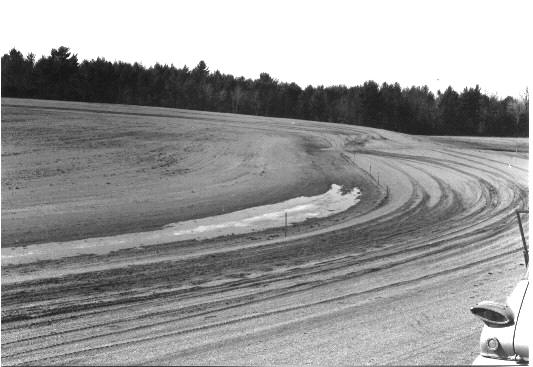
Source Unknown
Somebody's Plymouth Valiant sits by what
would become the exit ramp to the pits.
Below - This piece from June 21,
1965 shows the track was getting to completion
by that time.
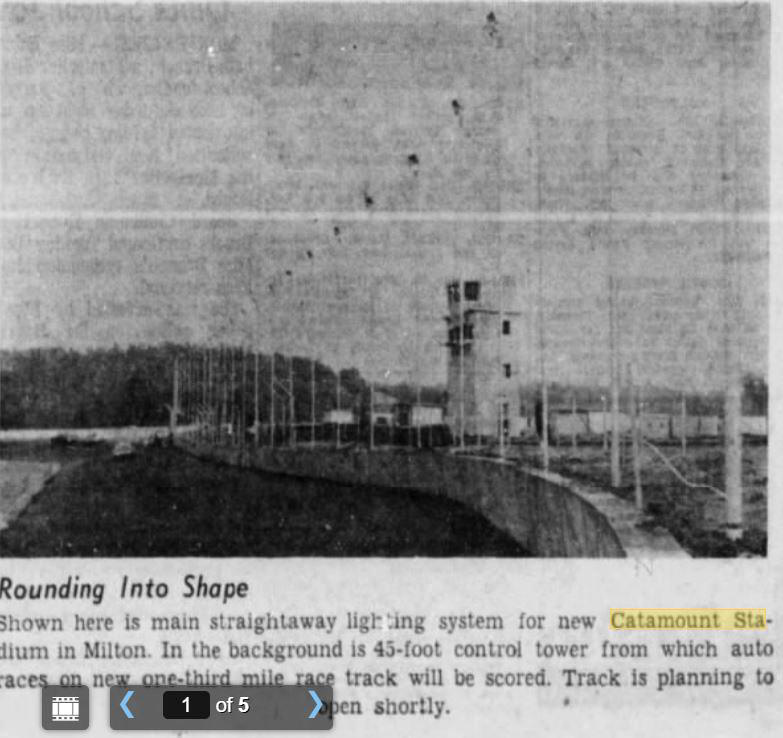
Burlington Free Press
It got to be a week or so before the track was to have its opening program and still there was no water source on the property. Jack Campbell convinced important staff member, Archie Blackadar [who lived in Danville, the host town of an annual dowsers' convention] to try dowsing water. While weeks of drilling had failed, Campbell walked around with the necessary apple tree branch and promptly found water [and not very far down] almost immediately. Problem solved.
Catamount would stagger through most of the 1965 season, scratching for enough cars to put on a show. I recall going to a show that year and seeing the same cars in more than one heat. Dubrul had journeyed to New York to obtain a “catamount” as track mascot, but public outcry made the management sell the old cat back, at a considerable loss. The track tried bicycle races, a SCODA sports car show, a Miss Catamount Stadium, and anything else they could – and they got through the first year.
Courtesy of Cho Lee
Flagger - turned Chief Pit Steward Archie Blackadar
[lft] poses with driver Tom Tiller
in a promo photo at the track. He recruited a
neighbor from his hometown to find
water on the site at the last moment. Below -
Dubrul's mascot find,
Nascat sits in misery in its cage.
Courtesy of Cho Lee
The lifespan of Catamount Stadium [sometimes Catamount International Speedway] from that 1965 season through the 1987 season. During that run, there wer some strange and kooky events that rippled through what was supposed to be a very well – mapped – out and smooth process. The first ripple came about outside the property markers of the track, on the property of the Sibley family. The boys, who were all getting on through their teens, decided to build a huge treehouse just off the Catamount property in a tree off turns one and two.
The track management immediately uncomfortable about the locattion of the perch, which was made even more uncomfortable when the sportsman coupe of Montreal's Marcel Godard went off the track and prodeeded to try and climb the tree holding the treehouse. The insurance company covering the track informed Squier that either the treehouse went or they would. Ken was momved to meet with the Sibley boys and give each one a good job at the track.
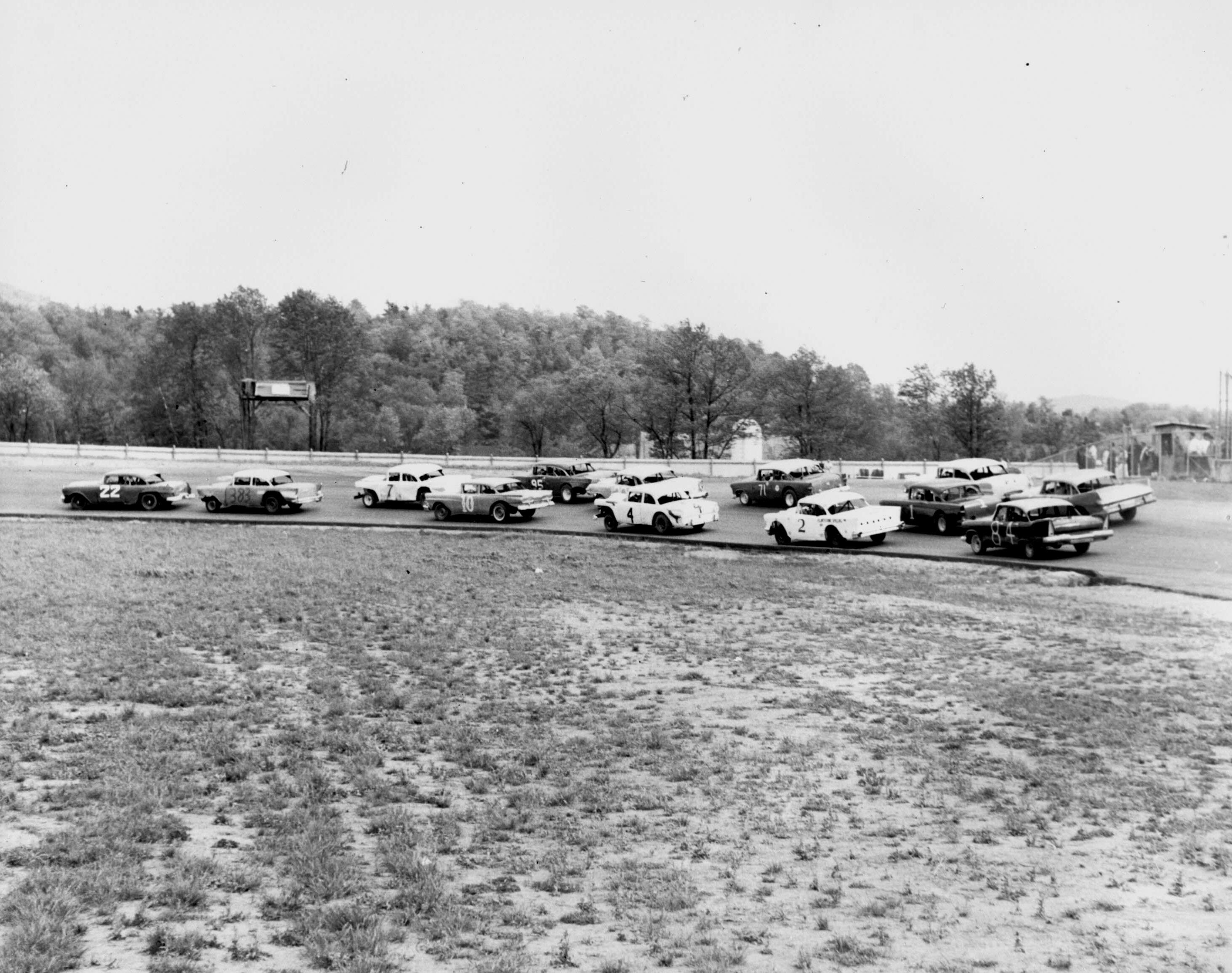
Courtesy of Cho Lee
The infamous treehouse looms in the distance as an
early field of Flying Tigers lumbers
into turn one. Below - Beaver and Bob Dragon
stand idly by in their driver's suits
as the Milton Fire Department gets there in time to
cool off the charred remains of
what had been a beautiful Ray Forte sportsman coupe.
Bob's car is seen above
the white cars 2 and 4 in the above photo.
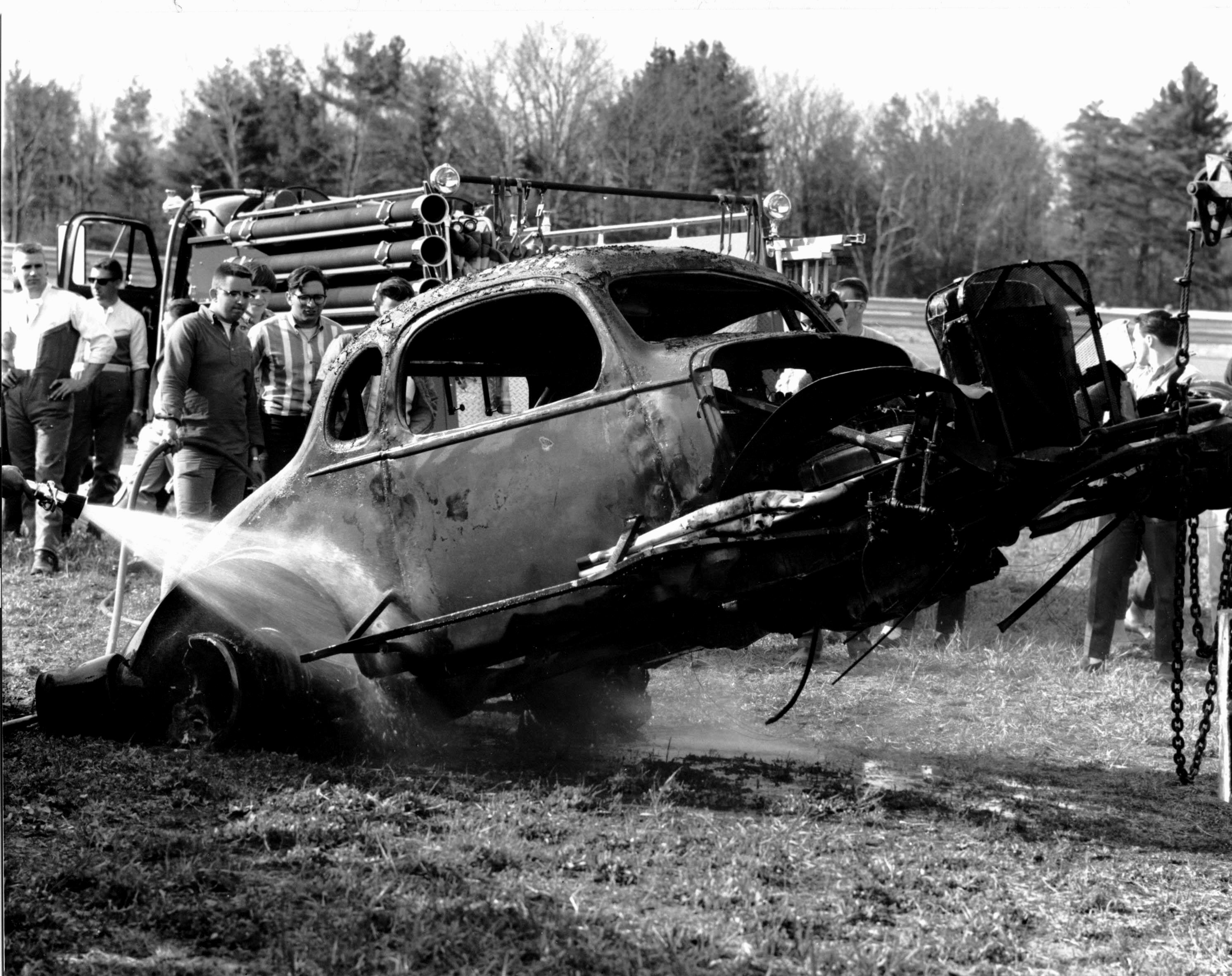
Courtesy of Cho Lee
Things went relatively calmly for the 1960's and well into the 1970's, except for the fires . By 1969, two cars had burned to the ground in spectacular fires before the small Milton Fire Department [whose role included Catamount stars Beaver and Bob Dragon] could get a truck out there. The expeerience and subsequent bad press would force the track to buy a big Ford pickup and equip it with a giant fire extinguisher. The extinguisher could puff out just about any fire if the track would only keep it charged; whether that happened or not was debatable.
The first feature event at the track in July of 1965 was won byu Canadian Jean-Paul Cabana; poetically, he would also win the final race there in 1987 - with decidedly different race cars than ever before. In between those two dates, he would come and go as the track experimented with what kinds of cars they would race over the years. The management would wisely choose to depart from the modified / sportsman coupes and sedans right at the time it seemed the track was at the top of the Northeast racing world in that division. The choice to pursue late model sportsman cars instead would turn out to be wise.

Courtesy of Cho Lee
The Jean-Paul Cabana 5A sportsman is seen on
the occasion of his winning the first - ever
feature at Catamount. Below - The car with Cabana won
the final race at the track.
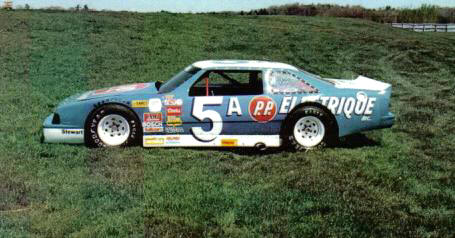
Courtesy of Andy Boright
Early in the 180's, with the track at the zenith of its role in the NASCAR late moedl sportman world, three events would add a little offbeat color to the otherwise fairly unexciting, corporate way the track was moving. First, the track decided to begin construction of a more elaborate tower, with luxury suits to accommodate some of the bigger – spending corporate supporters. That Spring, as the nearly – completed construction [soon to be dubbed The Milton Hilton] was close to completion, a loal boy, firtified won marijuana, decided to commandeer a piece of construction equipment and ram to supports of the new building; it nearly came down.
Within a minimal period of time from that auspicious launch of the luxury suites, other hell broke loose. Not in any chronological order, there occurred the great collapse and the great rift. Remember that the track's bleachers had been sitting there in place, from 1965 into the 1980's. They would hold their greatest weights in the heat of summer, sitting on pavement. At some point, it was discovered that some of the main bleachers were gradually settling as some of the pavement weaked from the heat. That was dealt with.
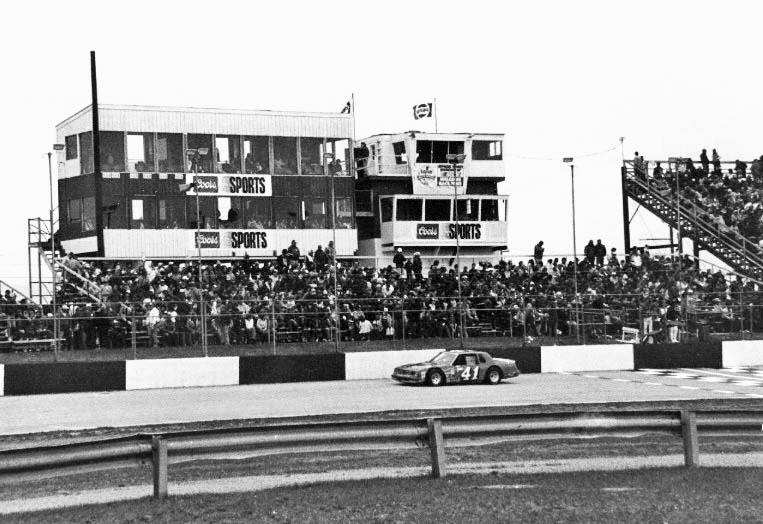
Courtesy of Cho Lee
Jamie Aubie's NASCAR North car speeds by the
stands, with the Milton Hilton
looming in the background to left of the original
tower. Below - The towering
newer bleachers are captured by Steve Pecor before
the final race program
at Catamount. The envroaching industrial park
buildings can be seen above
and to the right of the trent off turn one.
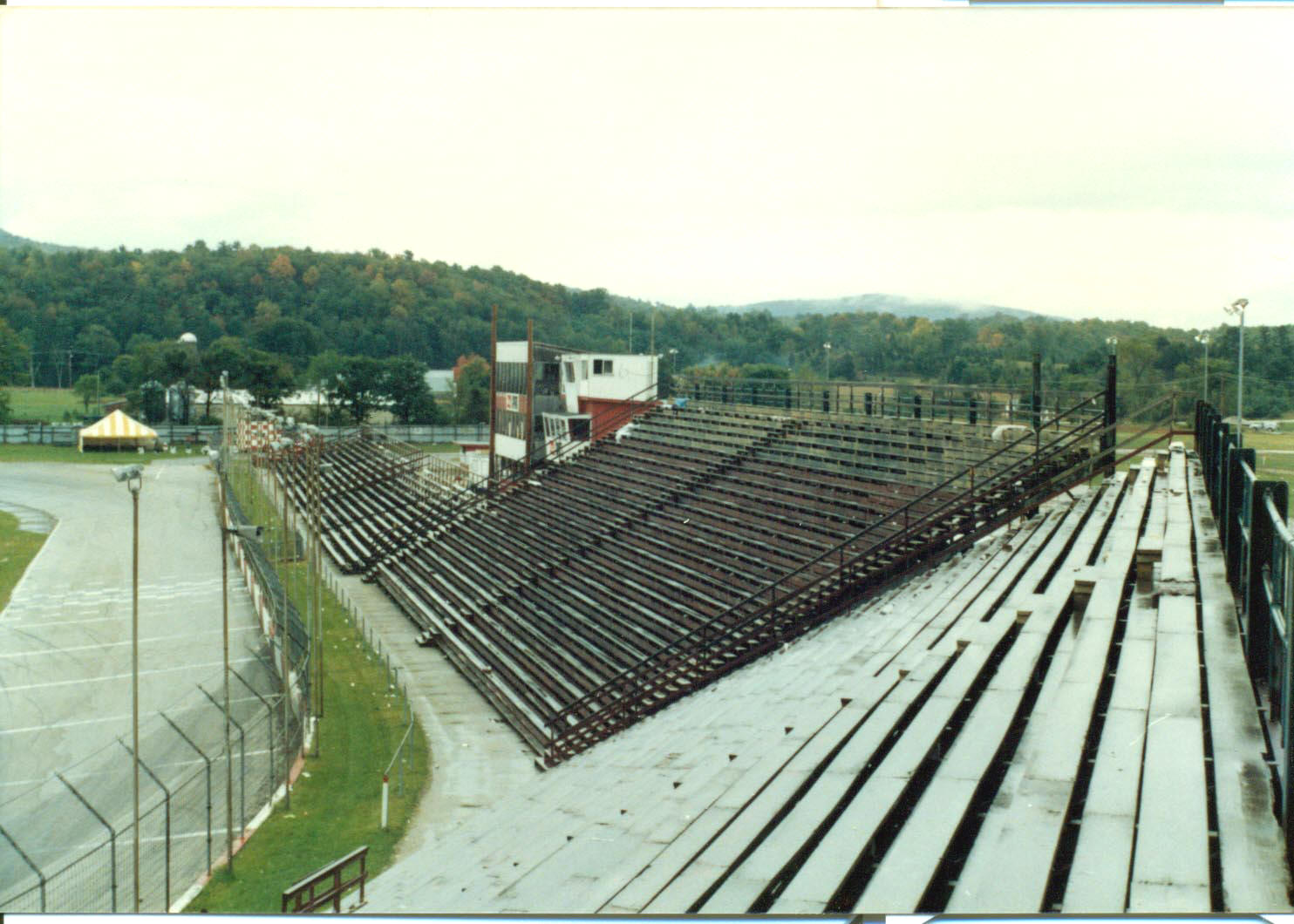
Actually, some of the original spectator bleachers were replaced, with much higher ones from Centennial Field, the ancient sports stadium at the University of Vermont. But, no attention was paid to the pit bleachers. One sunny afternoon, during a NASCAR North program being dominated by Robbie Crouch, people standing ion those bleachers felt a small jolt and a settling downward, Before anyone could react, the bleachers slowly and gently settled into a heap, partially upright from the materials which had first fallen.
While the feature was promptly red flagged, it was discovered that some people were hurt from jumping off various levels of the stands while others had legs trapped between section of the seats. While the few medical personnel sprang into action, anyone else with medical training rushed in to aid, as the track awaited all the local rescue squads who could respond. People were lying all over the ground around the bleachers as anxious others still stood or sat on the structure, having been told not to move any more that possible. They would be removed as quickly as possible. It was one of the least forgotten episodes in the history of the track.

Courtesy of Andy Boright
The collapsed pit bleachers sit late in the
day after the program was over. Below - Catamount
personnel and other volunteer people scramble to
assist the injured and to get people off
the unstable pit bleachers. An EMT yells instructions
to less trained helping hands.
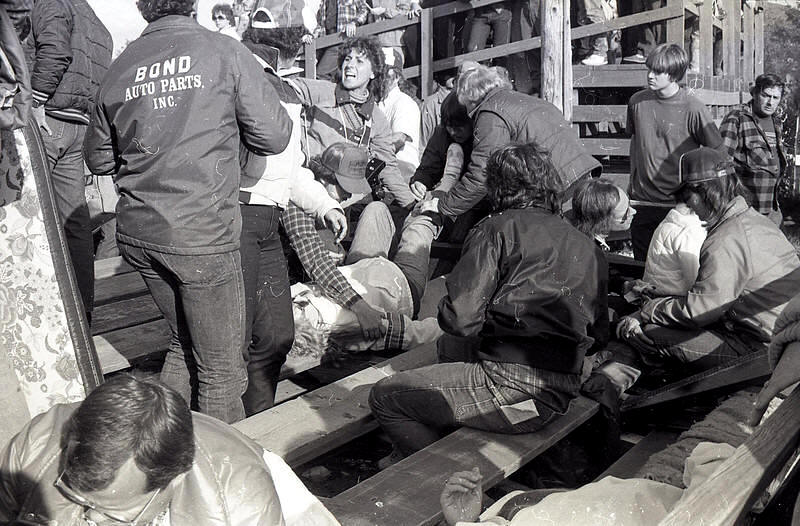
Courtesy of Cho Lee
During the 1982, for reasons most of us will never be apprised of, management of Catamount decided that things were not going as well as they had projected after a very healthy start of the late model sportman program in the 1970's. Northern NASCAR drivers [perhaps partially because they had so many tracks to drive at] were now appearing high in the NASCAR national sportsman standings, threatening what had been a Southeastern monopoly for years. In 1982, they decided to sell the land upn which Catamount sat to the Greater Burlingtron Industrial Corporation, acquiring a five – year lease to run the track. From that point on, they would neve again be in control in Milton.
Compounding this, the NASCAR North organization became more and more at odds with Daytona Beach. It is believed that a big flap over ho should have been the 1985 champion, as well as run – ins between the tour's beer sponsors and those of some of the individual race cars lent in with other tensions. After the 1985 season, the tour split with NASCAR, eventually becoming named the American – Canadian Tour. In 1986, the tour retained most of it teams; but, when the ACT decided to scrap the NASCAR – legal steel bodies for 1987, several of the bioggest teams either retired or went off with the newly – formed NASCAR Busch Grand National North circuit so they could retain their existing bodies.
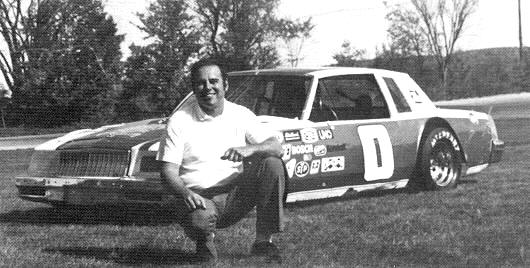
Source Unknown
Popular Kennebunkport, Maine driver Dick McCabe made
the decison to
keep his steel body equipment and go with the BGNN.
Below - Beaver
Dragon was enjoying a very free - spending sponsor
and team owner who
chose to go with the ACT plastic cars.
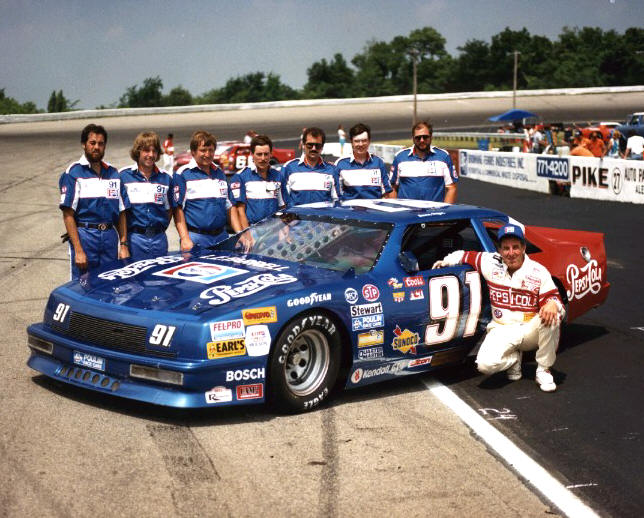
Courtesy of Donald Theis
The track went into the 1987 season with plastic – bodied pony cars, like those of the American Speed Association and the All Pro series. With some familiar names still running, many of the cars were raced by drivers almost totally unfamiliar to the fans. Cabana did manage to win the last race at the track with one of these new ACT cars. Unfortunately, other things did not go so well. The final track lap speed record went to a driver named Russ Urlin, whom few people evn knew. Also GBIC turned down the track request to extend the lease. The track's run was over.
The ACT tour survived very admirably, still actually running out of Catamount's then – sister track, Thunder Road up to the present time. Traces of Catamount continue to fade away or be constructed over by industrial development there. A Vermont historical marker has been posted on Route7, at the entrance to the property, Catamount Stadium has largely faded off into history like so many other tracks all over the country.
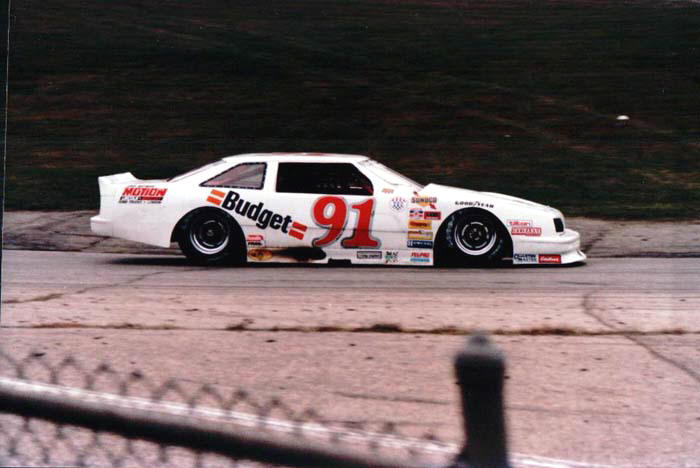
Courtesy of Andy Boright
Russ Urlin, upon the occasion of setting the track record. Enjoy your freaking record RUSS !
Please email me at wladabou@comcast.net if you have any photos to lend me or information and corrections I could benefit from. Please do not submit anything you are not willing to allow me to use on my website - and thanks. For those who still don’t like computers - my regular address is: Bill Ladabouche, 23 York Street, Swanton, Vermont 05488.
AS ALWAYS, DON’T FORGET TO CHECK OUT THE
REST OF MY WEBSITE:
www.catamountstadium.com
Return to the Main Page
Return to the Main News Page
Return to the All Links Page
Return to the Weekly Blog Links Page